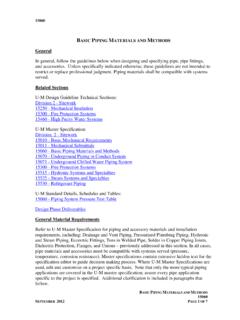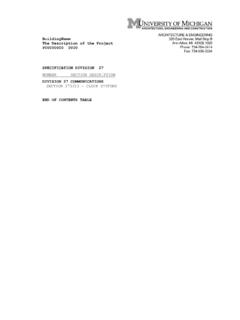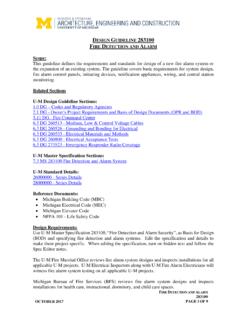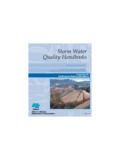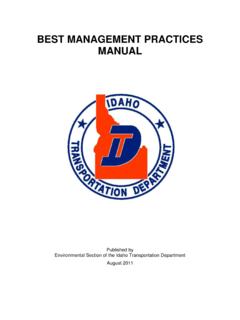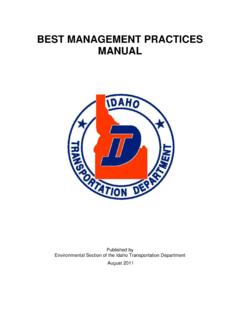Transcription of STORMWATER BEST MANAGEMENT PRACTICES
1 STORMWATER best MANAGEMENT . PRACTICES . University Planner's Office Architecture, Engineering & Construction In Association with OSEH EP3. University of Michigan January, 2011. Table of Contents A. Abbreviations page 3. B. STORMWATER MANAGEMENT page 4. Non-structural 1. Site disturbance and soil compaction page 4. 2. Natural/intermittent streams and swales page 5. 3. Buffer areas page 5. 4. Impervious surfaces page 5. 5. Overland flow page 6. 6. Terrain page 6. Structural 7. Bio-retention areas page 6. 8. Forebays and detention basins page 7. 9. Vegetated swales/filter strips page 7. 10. Underground filter chambers page 8. 11. Green roof page 8. 12. Native vegetation page 8. 13. Soil restoration program page 9. 14. Porous pavement page 9. C. Compliance page 10. The STORMWATER best MANAGEMENT PRACTICES manual is a companion OSEH's STORMWATER MANAGEMENT Program Plan ( ) and to the AEC Design Guidelines, which designers must also adhere to ( ).
2 UNIVERSITY OF MICHIGAN 2. STORMWATER best MANAGEMENT PRACTICES . A. Abbreviations 1. U-M University of Michigan 2. AEC Architecture, Engineering & Construction 3. UPO University Planner's Office 4. DPS Department of Public Safety 5. Grounds Plant Department/Grounds 6. OSEH Occupational Safety and Environmental Health 7. BMP best MANAGEMENT PRACTICES UNIVERSITY OF MICHIGAN 3. STORMWATER best MANAGEMENT PRACTICES . B. STORMWATER MANAGEMENT Goals: Use site specific strategies to protect water quality and prevent flooding, erosion and other negative impacts to campus buildings, infrastructure and the natural environment; maintain hydraulic balance in each watershed (as required per the U-M STORMWATER NPDES permit) for site disturbance 1 acre or greater or sites less than 1 acre that are part of a common plan of development where the total development will disturb 1 acre or greater ( ); minimize impervious coverage; and minimize infrastructure costs.
3 Non-Structural Strategies: 1. Limit site disturbance and soil compaction It is important to minimize soil compaction and site disturbance caused by construction activities. Avoiding compaction increases soil infiltration capacity, maintains a healthy environment for vegetation and preserves drainage ways and natural catchment areas. Site specific strategies for minimizing disturbance through design and construction PRACTICES include: a. Limit areas of heavy equipment access and staging/storage of materials. b. Identify and protect high-quality and environmentally sensitive areas- do not allow any disturbance to take place in these areas. c. Identify areas which will be vegetated after construction- avoid disturbance in these areas (clearing, but not grading). d. Avoid extensive and unnecessary clearing and stockpiling of topsoil.
4 E. Restore soil permeability to compacted areas that occurs during construction. f. Place temporary fencing around tree drip lines to avoid destruction of tree roots (following these guidelines: Tree% ). g. Minimize grading by designing to the existing topography. For additional detail refer to technical section 02215. ( ) and Soil Erosion & Sedimentation Control ( ). UNIVERSITY OF MICHIGAN 4. STORMWATER best MANAGEMENT PRACTICES . 2. Protect natural and intermittent streams and swales; maintain as natural habitat and campus amenity Identify, protect, and utilize natural drainage features, such as swales, low areas and watercourses as a means of protecting water quality. This maximizes the site's natural hydrological characteristics, reducing the need for structural MANAGEMENT PRACTICES and minimizing construction and maintenance costs.
5 Items to consider: a. Identify and map natural drainage features ( , swales, streams, low areas, wetland, etc.). Use signage and fencing for protection. b. Utilize natural topographic/drainage features to guide site design. c. Prevent erosion of natural drainage features by using upstream volume and rate control PRACTICES , such as level spreaders, erosion control matting, check dams, straw rolls, re- vegetation and outlet stabilization. 3. Protect and restore buffer areas to promote filtration Natural vegetated areas are important components of an integrated STORMWATER MANAGEMENT system that help protect water quality by stabilizing banks, mitigating flow rates, and filtering of pollution and sediment. Items to consider: a. Plan wide planted buffer zones/setbacks (50' buffers are preferred) around drainage courses, ponds and wetland.
6 B. Limit the amount of impervious surfaces and industrial uses allowed adjacent to buffer areas. c. Restrict clearing of vegetation within a 100-year floodplain. d. Restore buffer areas by revegetating it with native plantings, if possible. 4. Reduce impervious surfaces Reducing impervious surfaces includes minimizing the dimension or area required for roads, drives, walks and parking. When pavement is reduced, the rate of STORMWATER runoff is decreased while infiltration is increased. Items to consider: a. Evaluate traffic volumes and parking requirements taking into consideration average and peak use demand. b. Remove unutilized/underutilized impervious coverage. c. Consider minimizing impervious road and parking areas by incorporating pervious paving materials, where appropriate. d. Use pervious materials for plazas and sidewalks, and bike parking areas, where appropriate.
7 UNIVERSITY OF MICHIGAN 5. STORMWATER best MANAGEMENT PRACTICES . e. Reduce setbacks along roads to minimize length of access driveways and approach walks. f. Analyze the site to determine if smaller parking spaces, slanted parking stalls, compact car spaces, and narrowed traffic lanes are appropriate. 5. Promote overland flow Promote overland flow (where appropriate) to minimize need to costly infrastructure/reduce downstream impacts. When utilizing overland flow, consideration must be given to prevent erosion, wash-out, and to identify the water flow path that will occur. Water should be directed away from buildings and sensitive areas to prevent water from entering buildings, entrances, washing out landscaping beds, etc. 6. Work with existing terrain Work with the site's existing terrain to mitigate negative environmental effects.
8 Items to consider: a. Orient site surface features (roads, parking, walks, etc.) along existing contours to reduce need for cut/fill operations. b. Avoid increasing run-off on adjacent non-university properties, as well as avoid impacting neighboring site overland flow. Structural Strategies 7. Incorporate bio-retention areas Bio-retention areas, also referred to as rain gardens, are depressed surface areas typically no more than one acre in size that are planted with carefully selected native plantings whose function is to capture and treat STORMWATER runoff from rooftops, streets and parking lots. These areas help to moderate STORMWATER runoff, promote groundwater recharge and infiltration, create an aesthetically pleasing setting, provide wildlife habitat, and mitigate heat island effect if properly designed and located.
9 Items to consider: a. A commitment to regular maintenance is necessary so that the rain garden does not become over-run by weeds and non-native vegetation. b. In order to prevent clogging, a vegetated buffer strip, inlet or sediment trap should be installed prior to the runoff entry into the garden. c. Surface area should not exceed 5:1 impervious drainage area to bio-retention; ponding depth is recommended at 6 inches. d. Planting live material is preferred to seeding. UNIVERSITY OF MICHIGAN 6. STORMWATER best MANAGEMENT PRACTICES . 8. Utilize forebays and detention basins Detention basins are temporary STORMWATER storage areas that are used to help prevent downstream flooding by moderating STORMWATER runoff peaks. There are four different types: dry ponds, wet ponds, constructed wetlands and underground detention.
10 Forebays are smaller basins designed to take the initial flush of STORMWATER and slow the rate of flow before releasing into the detention basin. They are separated from the basin. Items to consider: a. Assess storage capacity of basin in lieu of available site area and soil/subsurface conditions. b. Consider combining with other BMPs for an integrated solution. c. Plan for regular maintenance vegetation and sediment removal. Maintenance may require the use of heavy equipment; plan for access routes, etc. accordingly. d. Evaluate surrounding sites when considering the development of a detention basin. Consider strategically locating a larger detention basin as opposed to constructing several smaller basins. e. Detention basins should be designed to accommodate a one-hundred year rainfall. Basins should meet U-M's STORMWATER NPDES permit requirement.
